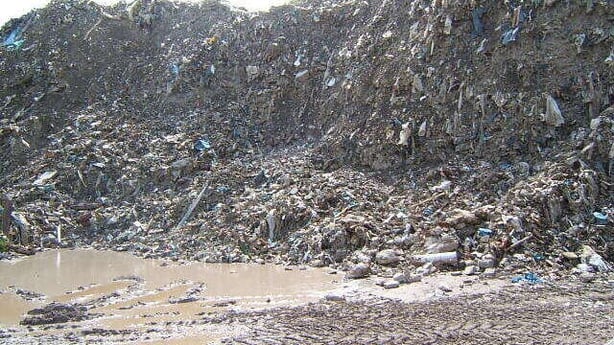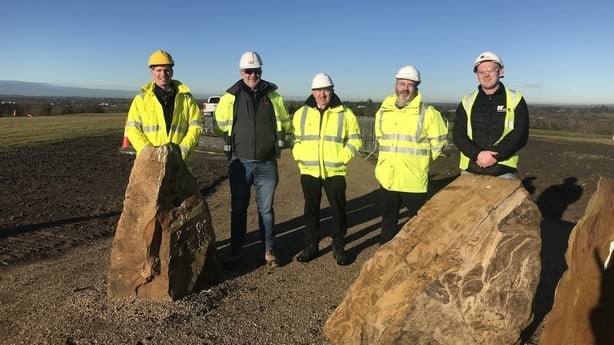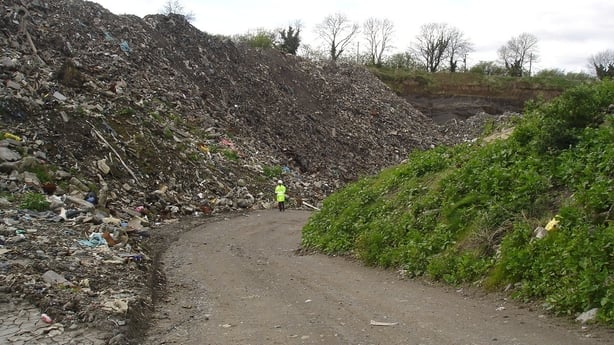A new park is set to open this autumn in Co Kildare at the site of an illegally operated waste dump, which has cost more than €61.5 million in public money to remediate.
Despite its high price tag, it is hoped that what was once a mountain of untreated waste, has now been contained and will become a popular public amenity.
Much of that price has been paid by locals living in the surrounding towns of Johnstown, Sallins and Naas who for decades have had to put up with foul-smelling odours carrying on the wind from the dump.
The situation became worse in January 2011 when a massive underground fire broke out after the dump ceased operations.
International experts had to be drafted in to control the fire, which ended up burning for close to a month, sending noxious fumes into people's homes and forcing some residents to temporarily move out.

Numerous complaints were made by local residents about the smell, with one woman telling RTÉ at the time that she was constantly having to monitor which way the wind was blowing as she feared what chemicals were being burned there. Others said the smell made them physically sick.
The Environmental Protection Agency said the conditions it gave for operating the dump from 2003 were disregarded almost as soon as it began business with a large amount of waste piled up in just one section. This now forms a hill at the centre of the new park.
"At one stage it was an enormous amount of waste, rising to a height of about 116 metres, now to put that into perspective, that's almost the height of the Spire on O'Connell Street," Tom Ryan, Director of the Office of Environmental Enforcement at the EPA told RTÉ News.
He said it was really important that this illegal operation be brought to a halt and that a prosecution of the company Nephin Trading Limited, along with its director take place.
A landmark judgment was made against the company Nephin Trading Limited in 2015 with the imposition of the biggest fine ever for an environmental crime, totalling €20m.
Last month its illegal operation led to one of the most significant prosecutions for environmental crime in the State when the retired director of the site, 71- year-old Tony Dean, was sentenced to three years in prison with the final 12 months of the sentence suspended at Dublin Circuit Criminal Court.
He was convicted by a jury last November of allowing waste to pile up there over two periods between October 2003 and November 2008.
Judge Melanie Greally said profits at the site had been prioritised over compliance.
The court heard that the quantity of the waste was unhelpful in terms of the fire but the cause of the fire could not be laid on Dean's door as the site was no longer under his company's control at this time.
"It was probably the most important and biggest case that we ever prosecuted with the DPP," explained Tom Ryan.
He said: "It was an enormous operation when it was first licensed in 2003. When we licensed it in 2003 it was for a waste management facility to process up to 600,000 tonnes of waste, assuming that they had the capacity to do that and the original licence would have held a whole suite of conditions to say what kind of waste they could manage on site, how it would be managed on site. Very early on in the process things started to go wrong."
Asked why the case had taken two decades to bring to finality in the courts, the EPA said it had been extremely complex legally.
Mr Ryan said: "It would appear that it's a very long time, but the actual offences occurred between 2003 and 2008. The indictment with the DPP commenced in 2011 and by any measure this was a very complex set of legal proceedings, so it wasn't just one case that took two decades."

He said it was a whole series of cases that had to test the law in the area and the case which had started in Dublin Circuit Criminal Court, went to the Court of Appeal, and all the way up to the Supreme Court before Dean's conviction last year.
Mr Ryan said: "We are very pleased that we have got the outcome that we have. It sends a very strong signal to companies and their directors and managers that engage in environmental crime, whether that's by neglect or connivance, that they will be held to account, no matter how long it takes."
However, he said such a prosecution is unlikely to ever occur again on this kind of scale due to major changes in how waste collection is operated and regulated.
He said: "A lot has changed over the last two decades. The whole enforcement and regulatory landscape has changed significantly.
"Now we have a National Waste Enforcement Steering Committee which I co-chair on behalf of the EPA with the Department of the Environment and that brings together all of the waste enforcement agencies around the country."
He said when the issues began to arise around Kerdiffstown in the early 2000s, there were about 90 landfill sites in the country, half of them being operated by local authorities and half privately.
The EPA said are only three landfill sites in the country that it licences.

Mr Ryan said there was still a chance that criminals could insert themselves into what is a complex industry by operating unlicensed sites and illegal dumping, with many investigations into this ongoing.
Site 'owes a debt to local community'
The transformation of the dump has come at a huge cost to the taxpayer and in this case, the EPA said it is unfortunate that the polluter has not paid the full price.
Joe Boland, the former Director of Services for Kildare County Council, which now runs the site has until recently been overseeing its transformation.
He said its first priority was to deal with the environmental risk: "It has been very challenging to deliver this.
"This is an environmental project first and foremost and the challenges here were to deal with all the environmental risks, particularly around gas management, odour management, effluent or leachate as it's called, particularly as we have the River Morell, which is very close to this site."
Mr Boland said interweaving the design of a park into the site whilst being aware of the environmental risks had been at the heart of the project, which he now hopes will give something back to the local community.
"There is no question that this site owes a debt to the local community," he explained.
He said the site is now probably one of the most analysed on the island of Ireland.
From an environmental, scientific and engineering perspective, he said Kildare County Council has carried out regular and detailed assessments to try to make sure there is no ongoing threat from what lies beneath.
He said: "The waste here is a combination of builders' waste, some domestic waste and the analysis has shown there isn't any hazardous waste here.
"The site has now been fully stabilised but in accordance with our licence from the Environmental Protection Agency, there is a requirement to monitor this into the future, so well into the future we'll have to continue to monitor this site."
Tom Ryan said he also welcomes the site's transformation into a park.
He said: "If there is some good to come from it, I think that's a very positive development. This is a community that suffered for a long time from the ills of this site and throughout this whole legal process, they've shown great resilience, integrity and courage in support of this legal process, so at least some good has come out of it for the local community."
Even after the park opens to the public this autumn, there will be periodic inspections from the EPA.
But on top of what was once the height of the dump, now stand three carved Celtic stones honouring St Brigid and from which the full amenities of the vast park can be viewed.
These include all-weather pitches which will facilitate rugby, soccer and football.
There are also running tracks, walking trails, arts features, biodiversity areas and wetlands.
"There's a lot of facilities here and indeed they're badly needed because if you look at the Naas, Sallins, Kill, Johnstown catchment there's a lot of young people," Mr Boland said.
Already many local sports clubs have expressed an interest in operating from the re-branded Kerdiffstown Park, with the council saying the excitement around it is already building.







